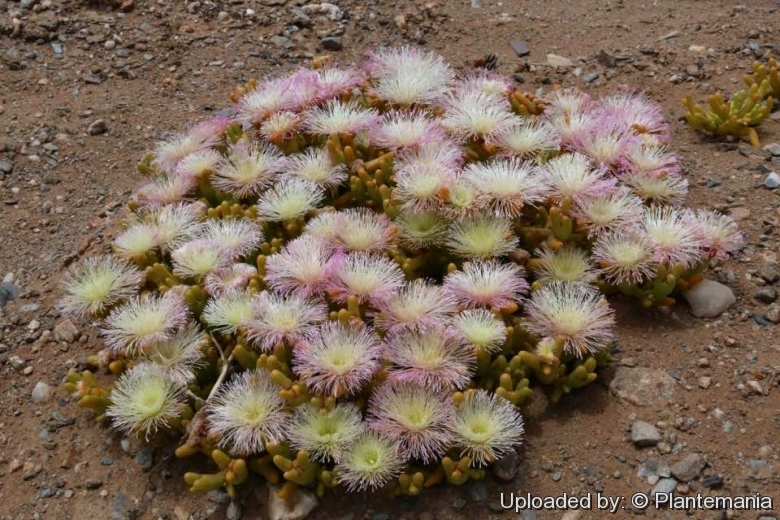Accepted Scientific Name: Mesembryanthemum hypertrophicum Dinter
Repert. Spec. Nov. Regni Veg. Beih. 23: 63, in obs. 1923

Mesembryanthemum aquosum Photo by: © Plantemania
In habitat.
Origin and Habitat: Opophytum aquosumSN|33860]]SN|33860]] occurs in South Western Namibia, Namaqualand, and Northern Cape, South Africa.
Habitat and ecology: This species is abundant on braksand or light clay on pans or gentle slopes, along coast road, along south bank of Orange River and in Richtersveldt, in winter rainfall areas. It is often found in disturbed places. The vegetation of vast areas is heavily degraded and invaded by O. aquosum and the biennial Mesembryanthemum squamulosum as well as non-succulent annuals. In the southern Namib the precipitation are of unpredictable amount and fall intermittently even annuals such as O. aquosum can resume growth once lack of moisture provisionally has forced them to stop. The amount water built up by annuals as a result of a rainfall event determines whether or not the plant can persist till the next event. In this respect succulent annuals appear to have an advantage over non-succulent annuals. They have a better rain gap endurance. This explains why succulent annuals often are so conspicuously abundant in arid areas, where rainfall events are few and temporally far between. Throughout the whole eastern plain, in good rain years, large colonies of the annual, O. aquosum occur.
Synonyms:
See all synonyms of Mesembryanthemum hypertrophicum
Description: Opophytum aquosumSN|33860]]SN|33860]] (= Mesembryanthemum hypertrophicum) is an extremely succulent, annual herb up to 100 cm in diameter and 25 cm tall, with flowers white to straw yellow (upper parts sometimes pink). The first flowers are formed very soon after germination, and the leaves have a comparatively high storage capacity which enables the plant to form flowers and to produce seeds for a long period independent from external water supply. It is fast-growing when compared with perennial species (e.g. O. aquosum can develop ten times more faster than the perennial Delosperma pergamemaceum). It uses its roots very temporarily following a rainstorm to take up water that is stored in all parts of the above ground body.
Derivation of specific name: The name 'aquosum', watery, is given because of the thick fleshy leaves.
Stems: Annual, decumbent to 25 cm tall, 100 cm in diameter without a basal vegetative rosette, prostrate when in flower. Internodes terete, up to 10 mm in diameter.
Leaves: Cylindrical, straight, to 70 mm long and 10 mm thick, with enlarged central water-storing cells, bladder cells (water vesicles) inconspicuous or flattened.
Flowers: Open day and night, scented at dusk, up to 60 mm in diameter, petals whitish to pale yellow, upper parts sometimes pink, very narrow, fused into a tube, petals, filamentous staminodes and stamens very numerous, nectaries tubular, stigmas pale yellow.
Fruits: The fruit is a capsules with valve wings reflexed and fused in pairs.
Seeds: Whitish to light brown, testa smooth. In the annual Opophytum aquosumSN|33860]]SN|33860]] the seed population consists of three types of seeds: a fast germinating, a slow germinating and a deep dormant portion (Von Willert et al., 1992). After a lag phase of more or less 10 days the fast germinating fraction germinates. After a second lag phase the slow germinating fraction germinates, quite well synchronized. However, even after this second phase of germination, However, even after this second phase of germination, a considerable portion of the seed population (the dormant fraction) remains ungerminated, forming a for future years.
Similar species: This species is very similar to Mesembryanthemum fastigiaturn.
Subspecies, varieties, forms and cultivars of plants belonging to the Mesembryanthemum hypertrophicum group.
Bibliography: Major references and further lectures
1) Dieter J. von Willert “Life Strategies of Succulents in Deserts: With Special Reference to the Namib Desert” CUP Archive, 13 February 1992
2) Karen van Rheede van Oudtshoorn, Margaretha W. van Rooyen “Dispersal Biology of Desert Plants” Springer Science & Business Media, 09 March 2013
3) Excelsa, Edizioni 13-17, Aloe, Cactus and Succulent Society of Rhodesia, 1988
4) Heidrun E.K. Hartmann “Illustrated Handbook of Succulent Plants: Aizoaceae F-Z” Springer Science & Business Media, 2002
5) The Cactus and Succulent Journal of Great Britain, Volume 33 Cactus & Succulent Society of Great Britain., 1971
6) von Willert, D. J., Eller, B. M., Werger, M. J. A., Brinckmann, E. and Ihlenfeldt, H.-D. (1992). “Life Strategies of Succulents in Deserts: With Special Reference to the
Namib Desert.” Cambridge University Press, Cambridge, England.
7) W. Richard J. Dean, Suzanne Milton “The Karoo: Ecological Patterns and Processes” Cambridge University Press, 24 June 1999
8) Wells, M.J., Balsinhas, V.M., Joffe, H., Engelbrecht, V.M., Harding, G. and Stirton, C.H. (1986) “A Catalogue of Problem Plants in Southern Africa, incorporating The National Weed List of South Africa.” Memoirs of the Botanical Survey of South Africa No. 53. Botanical Research Institute, Pretoria, South Africa.
9) Opophytum aquosum “Risultati di ricerca
10) Opophytum aquosum information from the “Global Compendium of Weeds” http://www.hear.org/gcw/species/opophytum_aquosum/
11) Norbert Jürges et al. “Desest biome” in: Strelitzia 19 2006.
12) Holotype of Opophytum aquosum (L.Bolus) N.E.Br. [family MESEMBRYANTHEMACEAE] Herbarium. The Bolus Herbarium (BOL), BOL128669 web: http://plants.jstor.org/stable/10.5555/al.ap.specimen.bol128669
Cultivation and Propagation: Opophytum aquosumSN|33860]]SN|33860]] (= Mesembryanthemum hypertrophicumSN|33854]]SN|33854]]) has white to straw yellow flowers and is not cultivated much.










